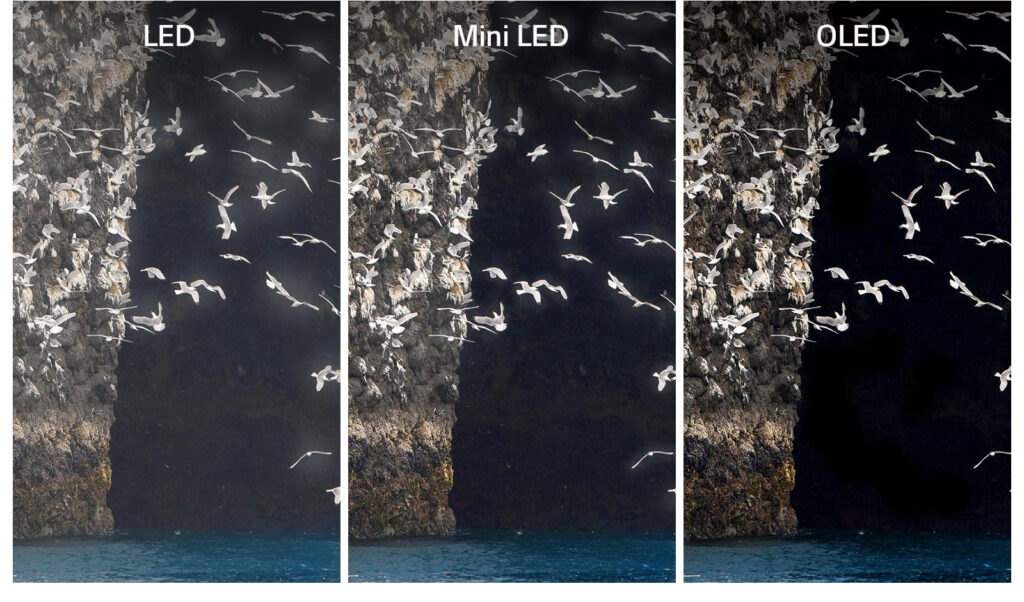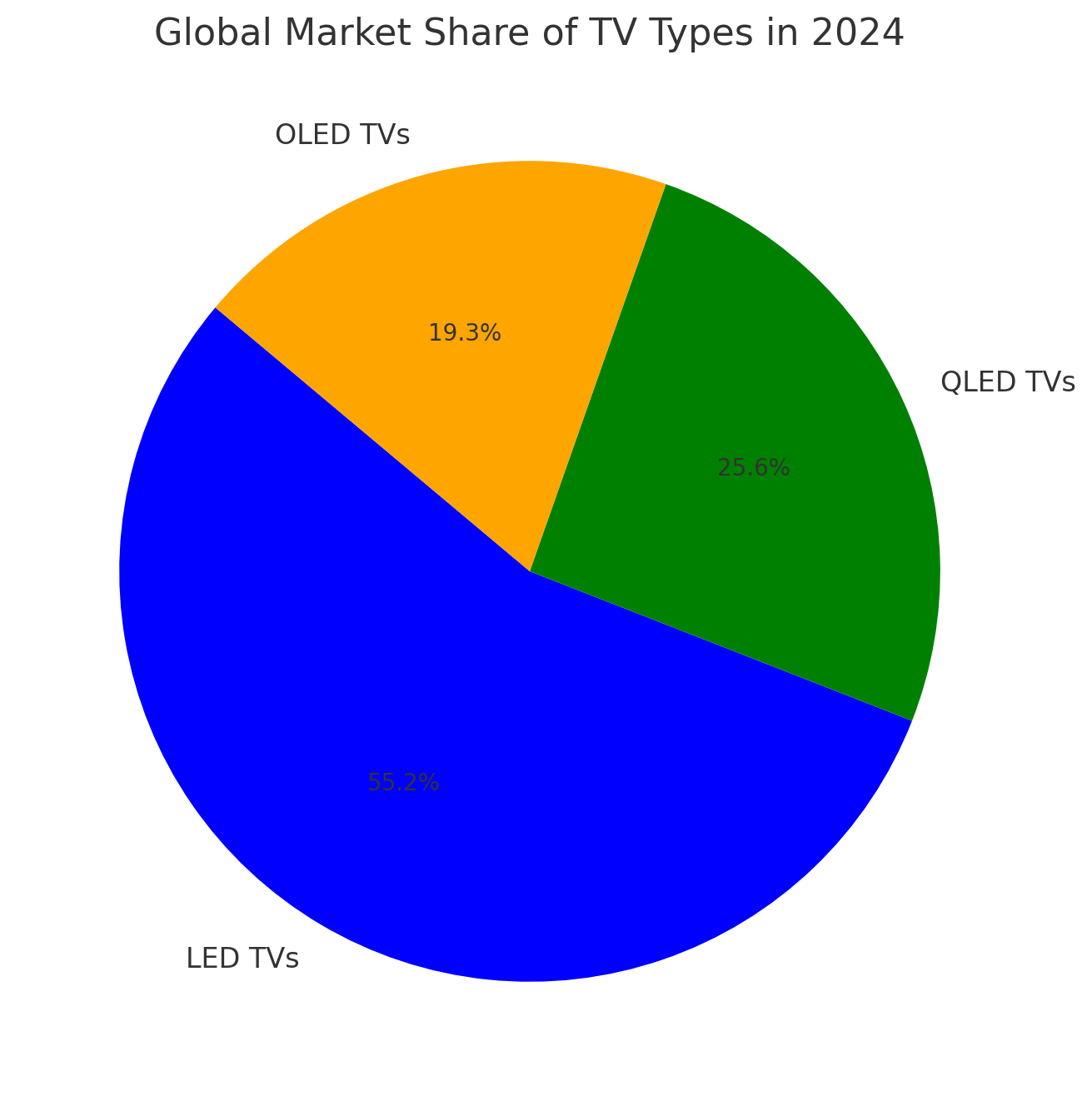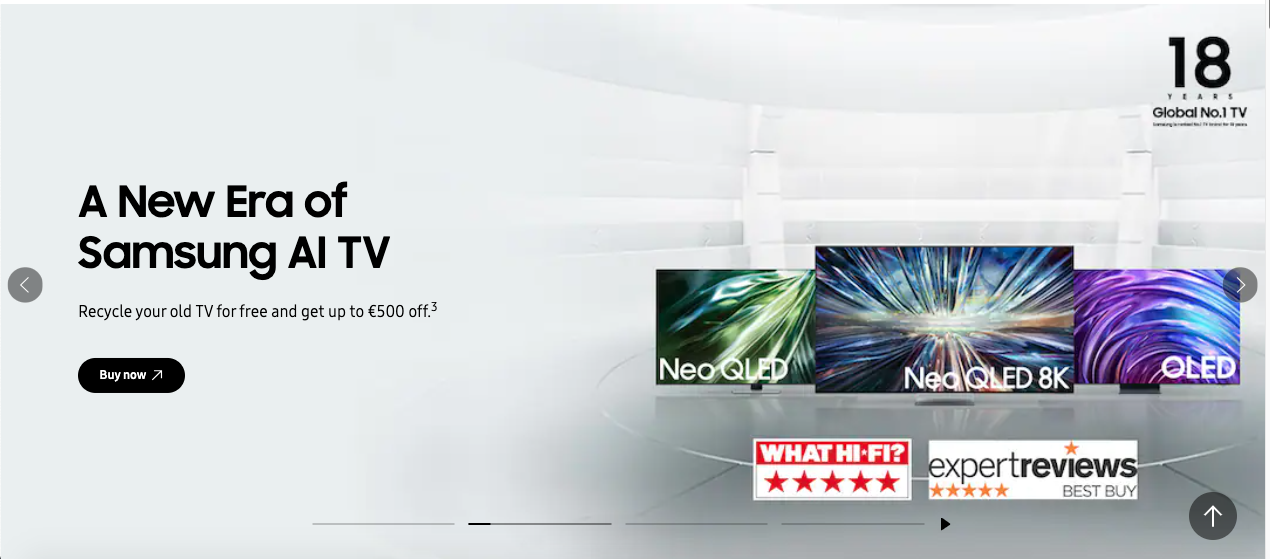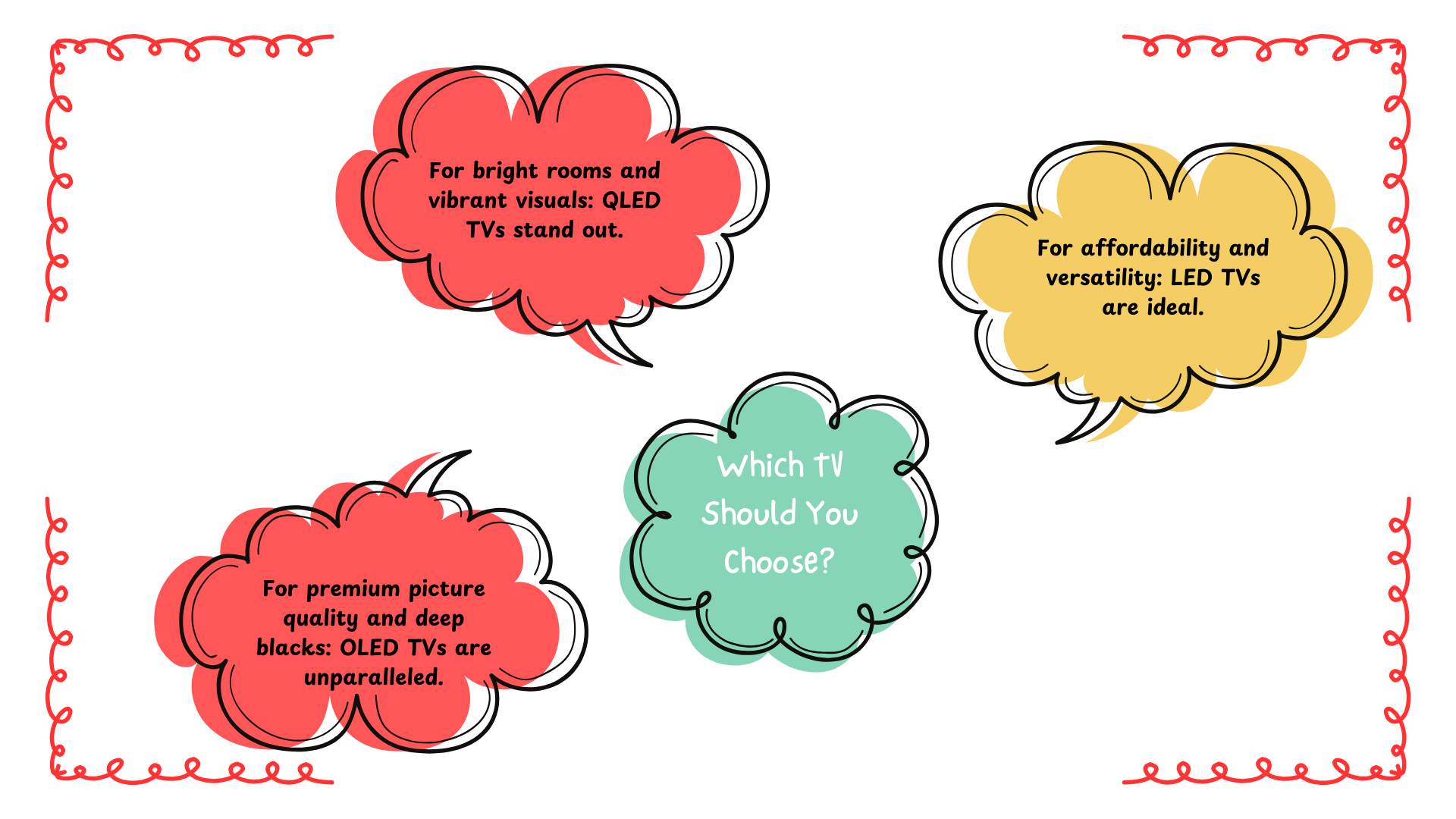With the rapid advancements in television technology, OLED, QLED, and LED TVs have emerged as three dominant display types, each offering unique features and benefits. Choosing the right TV depends on understanding these differences in detail. Below, we will explore the characteristics of each technology and provide deeper insights under expanded subheadings.

What Are LED TVs?
LED TVs are a variation of LCD technology, using LED backlighting instead of the fluorescent backlights found in older models. This advancement improves energy efficiency, screen brightness, and overall design.
How LED TVs Work
LED TVs rely on a backlighting system where LEDs illuminate the liquid crystal display (LCD) panel. The LCD controls light flow to create images by blocking or allowing light to pass through. This setup enables thinner screens and higher energy efficiency compared to traditional LCD TVs.
Advantages of LED TVs: Affordability: LED TVs are budget-friendly, offering a solid entry point into high-definition viewing. Wide Availability: Found in various sizes and designs, from compact screens to large formats. Energy Efficiency: LED technology consumes less power, making it more cost-effective over time. Enhanced Brightness: Ideal for rooms with ample ambient light or large windows.
Drawbacks of LED TVs: Contrast Issues: Struggles with deep blacks due to the inherent limitations of backlighting. Viewing Angle Limitations: Picture quality diminishes when viewed from side angles. Light Leakage: Bright areas on the screen can “bleed” into adjacent dark zones, reducing overall picture precision.
Who Should Choose LED TVs?
If you need a cost-effective TV for general use, such as watching TV shows or news in a bright room, LED TVs are an excellent choice.
What Are QLED TVs?
QLED TVs, or Quantum Dot LED TVs, enhance LED technology by adding a quantum dot layer, significantly improving color accuracy and brightness.
How QLED TVs Work
QLED TVs use quantum dots—tiny semiconductor particles that emit specific colors when illuminated by light. This layer sits between the LED backlight and the LCD screen, producing vivid and more precise colors while maintaining the high brightness levels associated with LED technology.
Advantages of QLED TVs : Superior Brightness: QLED TVs are among the brightest, suitable for well-lit rooms. Wide Color Gamut: Quantum dots enhance the richness and variety of displayed colors, making HDR content more dynamic. Durability: Unlike OLED, QLED TVs are less prone to screen burn-in and image retention. Scalability: Available in a wide range of sizes, from small screens to massive 98-inch models.
Drawbacks of QLED TVs: Inconsistent Blacks: Since QLEDs rely on backlighting, they cannot achieve the “true black” levels of OLED. Limited Viewing Angles: Despite improvements, side-viewing angles still result in slight color and contrast degradation. Higher Cost: Premium QLED TVs can approach the pricing of entry-level OLEDs.
Who Should Choose QLED TVs?
For those who prioritize vibrant colors, HDR performance, and high brightness—particularly in rooms with natural light—QLED TVs are an excellent choice.
What Are OLED TVs?
OLED (Organic Light-Emitting Diode) TVs represent a completely different display technology, where each pixel emits its own light, eliminating the need for a backlight.
How OLED TVs Work
In OLED screens, individual organic compounds emit light when electrically charged. Each pixel operates independently, meaning it can be turned on or off entirely. This capability creates unparalleled contrast ratios and true black levels.
Advantages of OLED TVs: Perfect Blacks: Each pixel can turn off completely, resulting in infinite contrast. Wide Viewing Angles: Picture quality remains consistent regardless of the viewer’s position.
Sleek Design: OLED panels are incredibly thin, enabling lightweight and innovative TV designs, including curved and rollable screens. Fast Motion Response: Ideal for gamers and sports enthusiasts due to near-instantaneous response times.
Drawbacks of OLED TVs: High Price: OLED technology is premium, reflected in its cost. Burn-In Risk: Prolonged display of static images (e.g., news channel logos) can lead to permanent marks. Brightness Constraints: OLED TVs are not as bright as QLED TVs, which may affect performance in brightly lit rooms.
Who Should Choose OLED TVs?
If you want the best picture quality, excellent contrast, and immersive viewing experiences, especially in a dim or dark room, OLED TVs are the ultimate choice.
Which Technology Offers Better Picture Quality?
OLED TVs lead the way with their ability to produce perfect blacks and unmatched contrast. However, QLED TVs shine in brightness and HDR content, making them highly competitive in well-lit settings. LED TVs, while sufficient for general use, fall short in achieving the depth and richness of OLED or QLED.
How Do These TVs Perform for Gaming?
OLED TVs: With their low input lag and fast response times, OLED TVs are the top choice for gaming enthusiasts, offering smooth visuals and minimal motion blur.
QLED TVs: They also perform well, especially for HDR gaming, where vibrant colors and high brightness enhance the experience.
LED TVs: Suitable for casual gaming but may struggle with motion clarity and higher input lag.
Which Technology Is Best for Watching Sports?
QLED TVs: The high brightness and vibrant colors make them ideal for sports, particularly in bright rooms or with large groups of viewers.
OLED TVs: Superior motion handling and wide viewing angles offer an immersive sports-watching experience.
LED TVs: A budget-friendly option for sports, though it may lack the fluidity and clarity of OLED or QLED during fast-paced action.
Which Is More Energy-Efficient?
OLED TVs are generally more energy-efficient due to their self-emissive pixels, which use power only when lit. However, QLED TVs have made significant improvements in efficiency and can outperform OLEDs in extremely bright settings. LED TVs, while efficient, are less so than these advanced technologies.
How Do Durability and Lifespan Compare?
QLED TVs: They are durable and immune to screen burn-in, making them suitable for long-term use in varied scenarios.
OLED TVs: While susceptible to burn-in, modern features mitigate this risk, ensuring longevity for most users.
LED TVs: Known for their robustness, LED TVs offer a practical balance of durability and cost.
What About Price vs. Performance?
LED TVs: The most budget-friendly, providing good value for those with limited needs. QLED TVs: Offer a balanced combination of quality and price, catering to a wide audience. OLED TVs: Deliver the best performance but come with a higher price tag, making them suitable for premium buyers.
Which TV Should You Choose?
Your decision should consider your needs, budget, and environment: For affordability and versatility: LED TVs are ideal. For bright rooms and vibrant visuals: QLED TVs stand out. For premium picture quality and deep blacks: OLED TVs are unparalleled.
With this detailed guide, you can confidently choose the technology that aligns with your preferences and lifestyle.
Global Usage Rates of OLED, QLED, and LED TVs
According to the data on https://news.samsung.com/, the usage rates of OLED, QLED, and LED TVs are as follows:

As of 2024, the global television market continues to be dominated by LED TVs, primarily due to their affordability and widespread availability. However, QLED and OLED TVs are progressively increasing their market shares, reflecting a growing consumer interest in advanced display technologies. LED TVs: LED TVs remain the most prevalent, accounting for the majority of global television sales. Their cost-effectiveness and extensive product range make them a popular choice among consumers. QLED TVs: QLED TVs, primarily produced by Samsung, have gained significant traction. In 2023, Samsung’s QLED TV lineup, including Neo QLED models, achieved sales of 8.31 million units, contributing to Samsung’s 30.1% share of the global TV market. OLED TVs: OLED TVs are favored in the premium segment for their superior picture quality. In 2023, Samsung’s OLED TV lineup recorded sales of 1.01 million units, capturing a 22.7% market share in the OLED sector.These figures indicate that while LED TVs continue to lead in overall usage, QLED and OLED TVs are progressively increasing their presence in the global market.
Which are the best brands in the world for OLED, QLED and LED TVs?
When selecting a television, understanding the leading brands in OLED, QLED, and LED technologies is essential. Here’s an overview of the top manufacturers excelling in each category:
OLED TVs:
LG: A pioneer in OLED technology, LG offers a diverse range of models known for their exceptional picture quality and innovative designs. The LG G4 OLED, for instance, is acclaimed for its brightness and color accuracy.
Sony: Sony’s OLED TVs, such as the A95L model, are celebrated for superior color accuracy and motion handling, making them ideal for cinematic experiences.
Samsung: Although a newer entrant in the OLED market, Samsung’s models like the S95D have garnered praise for integrating QD-OLED technology, combining the benefits of OLED’s deep blacks with QLED’s brightness.
QLED TVs:
Samsung: As the originator of QLED technology, Samsung‘s QLED TVs, such as the QN90D, are renowned for high brightness levels and vibrant colors, performing exceptionally well in brightly lit rooms.
Sony: Sony’s QLED models, like the Bravia 9, offer impressive contrast and color performance, catering to both gamers and movie enthusiasts.
Hisense and TCL: These brands provide budget-friendly QLED options without significantly compromising on quality, making advanced display technology more accessible.
LED TVs:
Sony: Sony’s LED TVs are noted for their robust performance, delivering excellent picture quality and reliability.
Samsung: Samsung offers a wide range of LED TVs, balancing performance and affordability, suitable for various viewing environments.
LG: LG’s LED models are recognized for their smart features and user-friendly interfaces, providing a comprehensive viewing experience.
When choosing a TV, consider factors such as viewing environment, content preferences, and budget to select the brand and technology that best align with your needs.






